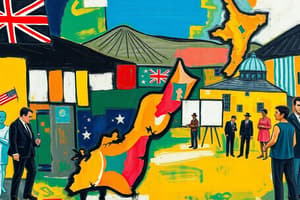Podcast
Questions and Answers
Who sighted New Zealand in 1642?
Who sighted New Zealand in 1642?
- Abel Tasman (correct)
- Samuel Marsden
- James Cook
- Henry Williams
What was the main aim of the Treaty of Waitangi?
What was the main aim of the Treaty of Waitangi?
- To establish British colonies in New Zealand
- To establish trade agreements between Māori and British
- To encourage large-scale immigration from Britain
- To protect Māori land rights and provide a framework for British settlement (correct)
What led to a significant influx of immigrants in the 1860s?
What led to a significant influx of immigrants in the 1860s?
- The discovery of gold in Otago (correct)
- The introduction of refrigerated shipping
- The Women's Suffrage Movement
- The establishment of the University of New Zealand
What was the population of New Zealand in 1858?
What was the population of New Zealand in 1858?
What was established in 1870?
What was established in 1870?
What was introduced in 1882, allowing for the export of meat and dairy products?
What was introduced in 1882, allowing for the export of meat and dairy products?
Who were among the first Christian missionaries to arrive in New Zealand?
Who were among the first Christian missionaries to arrive in New Zealand?
What was the main conflict between Māori and settlers?
What was the main conflict between Māori and settlers?
What right did women gain in 1893?
What right did women gain in 1893?
How many settlers arrived in New Zealand during the gold rush of the 1860s?
How many settlers arrived in New Zealand during the gold rush of the 1860s?
Flashcards are hidden until you start studying
Study Notes
European Settlement in New Zealand
Early Explorers and Missionaries (1642-1840)
- Dutch explorer Abel Tasman sighted New Zealand in 1642
- British explorer James Cook mapped the coastline in 1769-70
- Early European presence was limited to occasional visits by explorers, whalers, and missionaries
- Christian missionaries arrived in the early 19th century, including Samuel Marsden and Henry Williams
British Colonization (1840-1860)
- The Treaty of Waitangi was signed in 1840, granting the British Crown sovereignty over New Zealand
- The treaty aimed to protect Māori land rights and provide a framework for British settlement
- Large-scale British immigration began in the 1840s, with the establishment of settlements in Wellington, Nelson, and Auckland
- Conflicts arose between Māori and settlers over land ownership and usage
Gold Rush and Immigration Boom (1860-1880)
- The discovery of gold in Otago in 1861 led to a gold rush, attracting thousands of immigrants
- Immigration schemes and assisted passage programs encouraged large-scale migration from Britain
- The population of New Zealand grew rapidly, from approximately 60,000 in 1858 to over 500,000 by 1881
- The influx of settlers led to increased conflict with Māori over land and resources
Social and Economic Development (1880-1900)
- The late 19th century saw significant social and economic development in New Zealand
- The introduction of refrigerated shipping in 1882 allowed for the export of meat and dairy products
- The establishment of a national education system and the University of New Zealand in 1870
- The Women's Suffrage Movement gained momentum, with women gaining the right to vote in 1893
European Settlement in New Zealand
Early Explorers and Missionaries (1642-1840)
- Abel Tasman, a Dutch explorer, sighted New Zealand in 1642
- British explorer James Cook mapped the coastline in 1769-70
- Early European presence was limited to occasional visits by explorers, whalers, and missionaries until the early 19th century
- Christian missionaries, including Samuel Marsden and Henry Williams, arrived in the early 19th century
British Colonization (1840-1860)
- The Treaty of Waitangi was signed in 1840, granting the British Crown sovereignty over New Zealand
- The treaty aimed to protect Māori land rights and provide a framework for British settlement
- Large-scale British immigration began in the 1840s, with settlements established in Wellington, Nelson, and Auckland
- Conflicts arose between Māori and settlers over land ownership and usage
Gold Rush and Immigration Boom (1860-1880)
- The discovery of gold in Otago in 1861 led to a gold rush, attracting thousands of immigrants
- Immigration schemes and assisted passage programs encouraged large-scale migration from Britain
- New Zealand's population grew rapidly, from approximately 60,000 in 1858 to over 500,000 by 1881
- The influx of settlers led to increased conflict with Māori over land and resources
Social and Economic Development (1880-1900)
- The late 19th century saw significant social and economic development in New Zealand
- The introduction of refrigerated shipping in 1882 allowed for the export of meat and dairy products
- A national education system and the University of New Zealand were established in 1870
- The Women's Suffrage Movement gained momentum, with women gaining the right to vote in 1893
Studying That Suits You
Use AI to generate personalized quizzes and flashcards to suit your learning preferences.




